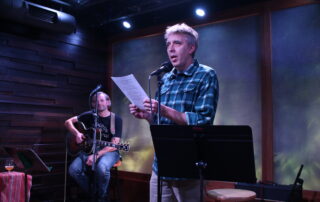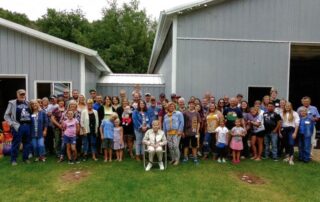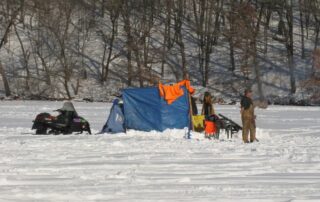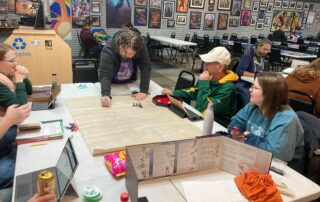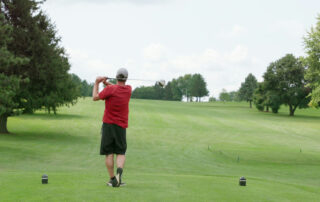For only the second time in 150 years, members of tribes from across the region and beyond played snow snake on Madeline Island as part of the Mooningwanakaaning Minis Inter-Tribal Snow Snake Festival. On a crisp Saturday in February 2023, the sun shined overhead as dozens gathered on a snow-covered Lake Superior beach.
Snow snake is a traditional game played by tribes during the winter. The game originated with the Haudenosaunee or Iroquois Confederacy out east. Tribal members craft javelins out of wood called snow snakes, and they compete to see who can throw them the farthest.

A channel is carved out of snow. It served as the track for competitors to throw their snow snakes down during a Madeline Island festival on Feb. 11, 2023. (Danielle Kaeding/WPR)
Competitors threw snow snakes down what looks like a channel carved out of snow. One of the participants in the men 55 and older group included Paul Ninham who’s a member of the Oneida Nation, which is one of the tribes that make up the Iroquois Confederacy. He has been teaching Indigenous games for almost four decades.

Oneida Nation tribal member Paul Ninham throws a snow snake given to him by his brother that’s made out of hickory at the Mooningwanakaaning Minis Inter-Tribal Snow Snake Festival on Feb. 11, 2023. (Danielle Kaeding/WPR)
“The snake has got to stay in there. It can and it will jump the track at times, and so that’s a no throw,” Ninham explained. “So, what we’re doing here is just kind of making up our rules … Everyone’s taking three throws.”
After individuals are done throwing, someone uses a flag to mark how far each person’s snake went. Ninham just got done throwing a snow snake made by his brother. Unfortunately, it veered off track.
“It was going pretty good I bet,” Ninham said.

Snow snakes can be various shapes and sizes. Some are made out of woods like hickory, maple, and popple. They can be decorated with tribal colors, burn marks, or other etchings. (Danielle Kaeding/WPR)
Snow snake and other Indigenous games hadn’t been played on the island until recently. The federal government banned the practice long ago due to wagering on the games. Oneida Nation tribal member Paul DeMain has described the festival as the Indigenous “Olympic Games.” He said bringing the game back to the island is part of a broader effort to restore tribal culture, lands, and language.
“This is something we do in our communities during the winter, and we’re just trying to bring it back a little bit more into context for the kids and giving them skills and encouragement, and fun and camaraderie,” Demain said.

Oneida Nation tribal member Paul DeMain emcees the Mooningwanakaaning Minis Inter-Tribal Snow Snake Festival as tribal and nontribal members compete on Feb. 11, 2023. (Danielle Kaeding/WPR)
Bill Quackenbush threw a longer snow snake made out of maple that he waxed to clinch the longest throw for men 55 and older at 309 feet. A tribal historic preservation officer for the Ho-Chunk Nation, Quackenbush said the game helped tribal members hone their hunting skills.
“In times of old, especially when the deer would herd up or if you’d have these groups of animals in there in waist-deep snow, a snow snake or spear of that time would travel very easily across the snow…and you could harvest animals if you needed to in the winter,” Quackenbush said.

Ho-Chunk Nation Tribal Historic Preservation Officer Bill Quackenbush highlights snow snakes that he brought to the festival on Feb. 11, 2023. They were made by different youth groups over the years and within his department. (Danielle Kaeding/WPR)
He said it’s good to see the game brought back to a place that plays an important role to northern Wisconsin tribes. Madeline Island is considered the ancestral homeland of the Ojibwe people, including the Red Cliff Band of Lake Superior Chippewa.
Red Cliff Tribal Member Sandy Gokee, who goes by the name Wenipashtaabe, had the longest throw among women 54 and under at 293.2 feet.
“It was a pretty epic throw,” she said. “I could feel it all the way from like the energy transfer from my shoulder all the way down my arm into the snake.”

Red Cliff tribal member Sandy Gokee, who goes by the name Wenipashtaabe, clinched the longest throw for women 54 and under at 293.2 feet. She’s pictured wearing what she calls her “super sacred cedar vision” shades on Feb. 11, 2023. (Danielle Kaeding/WPR)
For her, the game is a way to honor the suffering that their ancestors went through to hold onto their culture as the federal government forced them to assimilate and give up their lands.
“We don’t have to hide it. We’re right out in the middle of the lake now doing this. Hundred years ago up to 50 years ago, that wasn’t the case. We couldn’t do that,” she said. “Now, it’s my responsibility to my descendants to keep this going.”
It’s also important to Jenn Dodge. She made the trek to the island all the way from Ontario, Canada. A member of the Walpole Island First Nation, Dodge said cultural practices or speaking their language was not allowed for a long time.
“We might have kind of known something existed, but we didn’t get to grow up with it. Or, we didn’t get to continue it on and to share that with our families,” Dodge said. “Now, for me, that’s really important — sharing those games and bringing that back to our communities.”

Jenn Dodge prepares to throw a snow snake. She’s a member of the Walpole Island First Nation. Dodge said it’s important to share Indigenous games and bring them back to tribal communities on Feb. 11, 2023. (Danielle Kaeding/WPR)
Frank Sprague said he never knew the game growing up. He’s a member of the Gun Lake Band of Pottawatomi Indians from Southwest Michigan. Now, he makes his own snow snakes using wood like hickory, maple or popple that’s been dried in a kiln so they won’t warp over time. He said the game brings tribal communities together.
“The wintertime is very tough, very hard on us. We’re cooped up inside all day long, and it’s really gloomy,” Sprague said. “This is just a way for us to get out and compete in a good way.”

Frank Sprague with the Gun Lake Band of Pottawatomi Indians lines up his snow snake on the track on Feb. 11, 2023. (Danielle Kaeding/WPR)
Ninham with the Oneida Nation said the game was considered medicine because it lifted people’s spirits during the winter. He added that tribes also used snow snakes to send messages through markings on the wood when villages needed to meet or visitors were entering their territories. Ninham said it’s important to restore the games so that they’ll continue to be played long into the future.
“If we don’t continue to practice and play these games that the Creator has given us — our original games — those games are going to go away,” Ninham said.
While the cold of winter has settled over the island, Ninham said it warms his heart watching everyone play Indigenous games.



